The global hydrocyclone liners market is forecasted to grow from USD 92.6 million in 2025 to approximately USD 114.1 million by 2035, recording an absolute increase of USD 21.5 million over the forecast period. This translates into a total growth of 23.2%, with the market forecast to expand at a CAGR of 2.1% between 2025 and 2035. The market size is expected to grow by 1.2 times during the same period, supported by expanding mining operations across emerging economies, increasing mineral processing activities in established markets, and growing demand for efficient separation technology in industrial applications.
The steady market expansion reflects the critical role of protective liner technology in extending equipment lifespan and maintaining operational efficiency across diverse industrial separation processes. Mining companies worldwide are increasingly adopting specialized hydrocyclone liners to reduce maintenance costs while optimizing separation performance, with advanced material formulations and precision manufacturing techniques creating enhanced wear resistance characteristics for demanding applications including mineral concentration, slurry dewatering, and particle size classification in high-abrasion environments.
Manufacturing capabilities are advancing through specialized material processing technologies and precision molding systems that enable consistent quality control while reducing production costs. Leading manufacturers are investing in advanced polymer chemistry and ceramic processing equipment to create liner products that deliver superior abrasion resistance, extended operational life, and reliable performance under varying pressure and flow conditions. Industrial equipment suppliers and mineral processing specialists are expanding their hydrocyclone liner offerings to address specific application requirements across copper mining, iron ore processing, coal preparation, and industrial water treatment applications.
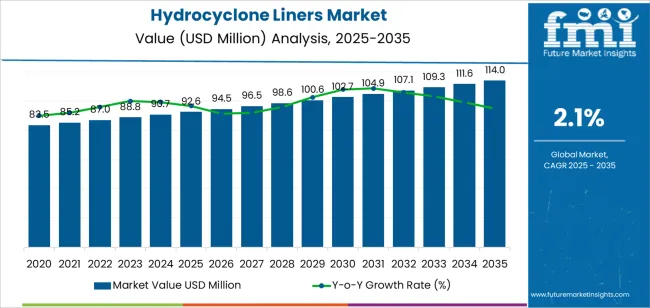
Quality standards continue evolving as applications demand higher durability specifications and consistent performance under extreme operating conditions including high-temperature slurries, corrosive environments, and extended operational cycles. Industry certification programs and testing protocols ensure reliable product performance while supporting market confidence in advanced liner technology adoption across critical mineral processing operations and regulated industrial environments. Compliance requirements for mining efficiency and environmental performance are driving investments in comprehensive quality assurance systems and validation procedures throughout the manufacturing supply chain.
International mining coordination is supporting market development as major mineral extraction projects require standardized liner solutions across multiple processing facilities. Global mining companies are establishing unified specifications for hydrocyclone performance that influence worldwide procurement standards and create opportunities for specialized liner manufacturers. Mining engineering firms are forming partnerships with equipment suppliers to develop application-specific liner solutions tailored to emerging extraction requirements and mineral processing equipment specifications.
Investment patterns are shifting toward integrated separation solutions as processing facilities seek comprehensive hydrocyclone systems that combine advanced liner technology with enhanced material performance and maintenance-friendly characteristics. Industrial companies are implementing standardized liner specifications across their operations, while equipment manufacturers are incorporating advanced liner technology into their separation system designs to ensure processing efficiency and operational reliability. This trend toward standardization and performance optimization is reshaping competitive dynamics across the industrial separation equipment value chain.
Market maturation is evident in the emergence of specialized application segments that demand unique material characteristics and performance specifications. Food processing applications require FDA-approved polymer formulations and sanitary design features under strict hygiene requirements, while oil and gas operations need liners that maintain performance during high-pressure separation processes and provide consistent efficiency in hydrocarbon processing environments. These specialized requirements are driving innovation in material science, manufacturing technologies, and integration methodologies that extend beyond traditional mining separation applications.
| Metric | Value |
|---|---|
| Market Value (2025) | USD 92.6 million |
| Market Forecast Value (2035) | USD 114.1 million |
| Forecast CAGR (2025-2035) | 2.1% |
| MINING EXPANSION | EFFICIENCY OPTIMIZATION | MATERIAL ADVANCEMENT |
|---|---|---|
| Mineral Extraction Growth -- Global mining operations requiring specialized liner technology for copper, iron ore, and precious metals processing with enhanced separation efficiency, reduced maintenance requirements, and extended equipment life supporting operational cost reduction and production optimization across established and emerging mineral extraction regions. | Processing Efficiency -- Industrial facility improvements implementing advanced liner technology for operational efficiency, reduced downtime requirements, and enhanced separation performance while maintaining productive processing environments and quality standards for mineral concentration applications. | Advanced Materials -- Manufacturing technology development requiring specialized liner components for mineral processing equipment, separation systems, and facility infrastructure with enhanced performance and standardized specifications for diverse operating conditions. |
| Resource Development -- Industrial mining advancement requiring integrated liner solutions for automated processing systems, material handling operations, and extraction applications with superior wear resistance and reliability characteristics supporting large-scale mineral processing requirements. | Operational Compliance -- Industrial facility standards requiring comprehensive separation control solutions for processing operations, equipment installations, and facility expansions with documented performance and certification requirements meeting environmental and safety regulations. | Technology Integration -- Processing system optimization requiring specialized liner technology for industrial equipment, automated separation processes, and facility infrastructure with enhanced performance characteristics and proven reliability specifications. |
| Infrastructure Investment -- Mining component suppliers implementing comprehensive liner solutions for industrial processing projects, facility installations, and equipment upgrades with specialized design characteristics and performance specifications supporting global mineral extraction operations. | Regulatory Requirements -- Industrial safety standards and environmental control regulations requiring certified liner performance for processing facilities, equipment operations, and worker protection with comprehensive compliance documentation and testing validation procedures. | Cost Effectiveness -- Processing cost reduction initiatives requiring durable liner solutions for separation systems, equipment maintenance optimization, and facility operational efficiency with proven performance and reliability characteristics supporting competitive mineral processing operations. |
| Category | Segments / Values |
|---|---|
| By Type | Ceramic; Rubber; Polyurethane; Metal-Backed; Composite Materials; Others |
| By Application | Mining & Mineral Processing; Oil & Gas; Pulp & Paper; Food and Beverage; Wastewater Treatment; Chemical Processing; Others |
| By End-User | Mining Companies; Industrial Equipment Manufacturers; Processing Plant Operators; Water Treatment Facilities; Oil & Gas Companies; Others |
| By Material Properties | High Wear Resistance; Chemical Resistant; Temperature Resistant; Standard Performance; Others |
| By Size Range | Small Diameter (up to 150mm); Medium Diameter (150-500mm); Large Diameter (500mm+); Others |
| By Region | North America; Europe; Asia Pacific; Latin America; Middle East & Africa |
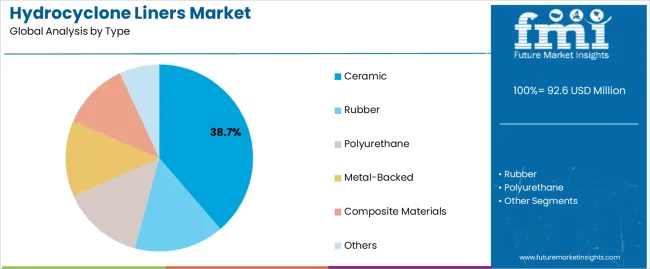
| Segment | 2025-2035 Outlook |
|---|---|
| Ceramic | Leader in 2025 with 38.7% market share; preferred material for high-abrasion mining applications and mineral processing operations requiring superior wear resistance and extended operational life. Widely adopted across copper mining and iron ore processing facilities. Momentum: strong growth across mining expansion and mineral processing segments. Watchouts: higher initial costs compared to polymer alternatives in cost-sensitive applications. |
| Rubber | Growing segment with 24.6% share, favored for moderate abrasion applications and water treatment processes requiring chemical resistance and installation flexibility. Momentum: steady growth in water treatment and chemical processing applications. Watchouts: limited performance in extreme temperature and high-abrasion environments. |
| Polyurethane | Established segment serving applications requiring impact resistance and moderate wear protection for diverse industrial separation processes. Momentum: consistent growth in specialized industrial applications and custom processing system designs. Watchouts: temperature limitations in high-heat processing environments. |
| Metal-Backed | Specialized segment for extreme duty applications requiring maximum durability and extended service life in demanding mining operations. Momentum: selective growth in large-scale mining operations requiring premium performance solutions. Watchouts: significantly higher costs limiting adoption in standard processing applications. |
| Others | Includes composite materials and specialty formulations for unique application requirements. Momentum: emerging growth in specialized processing and custom industrial applications. |
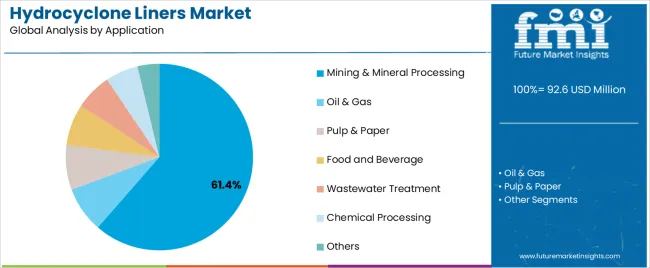
| Segment | 2025-2035 Outlook |
|---|---|
| Mining & Mineral Processing | Largest application segment in 2025 at 61.4% share, driven by global mining expansion and mineral processing facility upgrades requiring effective separation solutions for ore concentration, tailings management, and material classification operations. Momentum: robust growth from mining infrastructure development and mineral extraction advancement across emerging markets. Watchouts: commodity price volatility affecting capital equipment investments in mining operations. |
| Oil & Gas | Critical segment representing 16.8% share, experiencing steady growth from upstream processing facility expansion and equipment modernization requiring separation solutions for produced water treatment and hydrocarbon processing. Momentum: consistent growth as oil and gas facilities upgrade separation systems and improve operational efficiency. Watchouts: market volatility and environmental regulations affecting upstream investment patterns. |
| Pulp & Paper | Established segment at 12.3% share for specialized pulp processing applications and paper mill operations requiring dedicated separation solutions for fiber recovery and process water treatment. Momentum: moderate growth from facility modernization and efficiency improvement initiatives. Watchouts: industry consolidation and digital media impact limiting new facility investments. |
| Others | Includes food and beverage, wastewater treatment, and chemical processing applications. Momentum: diverse growth opportunities across multiple industrial sectors and emerging separation applications. |
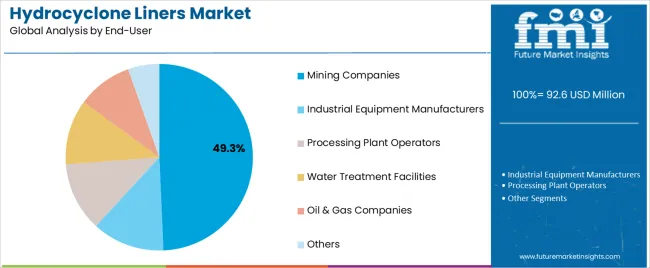
| End-User | Status & Outlook (2025-2035) |
|---|---|
| Mining Companies | Dominant end-user in 2025 with 49.3% share for direct separation system installations and processing facility equipment requirements. Provides operational efficiency, reduced maintenance costs, and enhanced mineral recovery for extraction operations. Momentum: steady growth driven by mining expansion and processing facility modernization. Watchouts: commodity market pressures and environmental compliance requirements affecting capital investment decisions. |
| Industrial Equipment Manufacturers | Technical end-user serving original equipment manufacturer applications and integrated separation system solutions requiring certified liner performance and reliability specifications. Momentum: moderate growth as equipment suppliers enhance separation offerings and system integration capabilities. Watchouts: competitive pressure and performance specification requirements in diverse industrial applications. |
| Processing Plant Operators | Operations end-user for facility upgrade applications and performance optimization projects serving industrial maintenance and system enhancement requirements. Momentum: consistent growth as processing facilities maintain and upgrade existing separation installations. Watchouts: budget constraints and operational disruption concerns limiting upgrade project timelines. |
| Others | Includes water treatment facilities, oil and gas companies, and specialty industrial end-user categories. Momentum: selective growth opportunities in specialized applications and emerging industrial sectors. |
| KEY TRENDS | DRIVERS | RESTRAINTS |
|---|---|---|
| Advanced Material Development -- Enhanced ceramic formulations and polymer technology delivering improved abrasion resistance, chemical compatibility, and temperature performance for demanding separation applications with extended service life and reduced maintenance requirements supporting operational cost optimization. | Mining Industry Expansion across global markets and developing regions creating substantial demand for separation equipment and liner technology supporting mineral extraction, ore processing, and materials handling operations requiring reliable performance and operational efficiency. | Capital Investment Constraints in mining and industrial sectors affecting adoption of premium liner solutions across cost-sensitive processing facilities and competitive industrial applications with restricted capital equipment budgets and procurement standardization requirements. |
| Precision Manufacturing -- Expanding integration with automated production systems, quality control technologies, and advanced molding techniques enabling consistent performance characteristics, dimensional accuracy, and material property optimization for diverse separation applications and operating environments. | Environmental Compliance -- Industrial regulations and environmental standards driving adoption of efficient separation technology for mining operations, water treatment facilities, and industrial processing applications requiring documented performance and regulatory validation for waste management and resource recovery. | Technical Complexity -- Application-specific requirements, installation procedures, and performance validation affecting deployment timelines and operational capabilities for industrial facilities lacking specialized separation system expertise and maintenance capabilities for advanced liner technology. |
| Application Diversification -- Integration with emerging industrial processes including battery material processing, recycled material recovery, and specialty chemical separation enabling comprehensive separation solutions for non-traditional applications requiring specialized performance characteristics and regulatory compliance. | Operational Efficiency -- Industrial facility upgrades and processing system enhancements requiring specialized liner components for improved separation performance, reduced energy consumption, and enhanced material recovery with superior operational reliability and maintenance optimization. | Market Fragmentation -- Diverse industrial applications, equipment specifications, and regional requirements creating complexity for suppliers developing standardized liner solutions across multiple processing sectors and international markets with varying technical standards and performance criteria. |

| Country | CAGR (2025-2035) |
|---|---|
| China | 2.8% |
| India | 2.6% |
| Germany | 2.4% |
| Brazil | 2.2% |
| United States | 2.0% |
| United Kingdom | 1.8% |
| Japan | 1.6% |
Revenue from hydrocyclone liners in China is projected to exhibit steady growth with a market value of USD 32.7 million by 2035, driven by extensive mining modernization programs and comprehensive mineral processing infrastructure development creating substantial opportunities for liner technology suppliers across copper extraction, iron ore processing, and coal preparation facility sectors. The country's ambitious mining development programs including national resource extraction initiatives and automated processing facility expansion are creating consistent demand for specialized separation liner systems. Major mining companies and industrial equipment suppliers including China Minmetals, Shenhua Group, and specialized separation equipment manufacturers are establishing comprehensive liner solution programs to support large-scale mineral processing and advanced extraction technology applications.
Revenue from hydrocyclone liners in India is expanding to reach USD 15.4 million by 2035, supported by extensive mining industry development programs and comprehensive industrial infrastructure modernization initiatives creating demand for separation liner solutions across diverse mineral processing facility and industrial application segments. The country's growing mining capabilities and expanding processing infrastructure are driving demand for liner components that provide exceptional reliability while supporting advanced mineral processing system requirements. Industrial companies and mining facilities are investing in separation liner technology to support growing mineral extraction demand and industrial processing advancement requirements.
Demand for hydrocyclone liners in Germany is projected to reach USD 18.2 million by 2035, supported by the country's leadership in industrial processing technology and advanced separation systems requiring sophisticated liner solutions for precision manufacturing and specialized industrial applications. German processing operators are implementing cutting-edge liner platforms that support advanced operational capabilities, precision performance, and comprehensive quality monitoring protocols. The market is characterized by focus on engineering excellence, technology innovation, and compliance with stringent industrial safety and performance standards.
Revenue from hydrocyclone liners in Brazil is growing to reach USD 12.7 million by 2035, driven by mining infrastructure development programs and increasing mineral processing capabilities creating opportunities for liner suppliers serving both mining operators and specialized equipment contractors. The country's expanding mining sector and growing mineral processing infrastructure are creating demand for liner components that support diverse extraction requirements while maintaining performance standards. Mining companies and processing facilities are developing technology strategies to support operational efficiency and system reliability advancement.
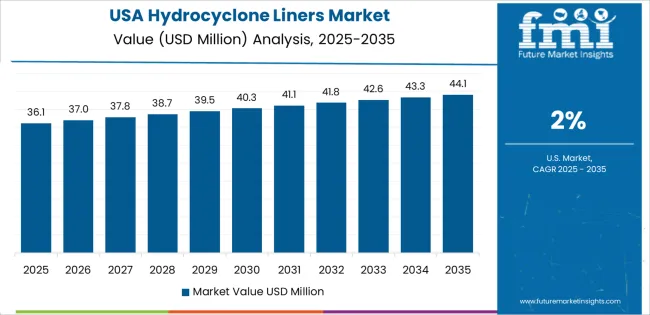
Demand for hydrocyclone liners in United States is projected to reach USD 16.8 million by 2035, expanding at a CAGR of 2.0%, driven by advanced processing technology innovation and specialized industrial applications supporting precision separation and comprehensive automation technology applications. The country's established mining technology tradition including major equipment manufacturers and processing facilities are creating demand for high-performance separation liner components that support operational advancement and safety standards. Manufacturers and industrial system suppliers are maintaining comprehensive development capabilities to support diverse mining and processing requirements.
Revenue from hydrocyclone liners in United Kingdom is growing to reach USD 9.3 million by 2035, supported by industrial processing heritage and established engineering communities driving demand for premium separation liner solutions across traditional processing systems and specialized industrial applications. The country's rich industrial engineering heritage including major processing companies and established industrial system capabilities create demand for liner components that support both legacy system advancement and modern processing applications.

Demand for hydrocyclone liners in Japan is projected to reach USD 8.7 million by 2035, driven by precision processing technology tradition and established industrial leadership supporting both domestic separation system markets and export-oriented component production. Japanese companies maintain sophisticated separation liner development capabilities, with established manufacturers continuing to lead in liner technology and industrial equipment standards.
How is the Europe market divided based on application focus?
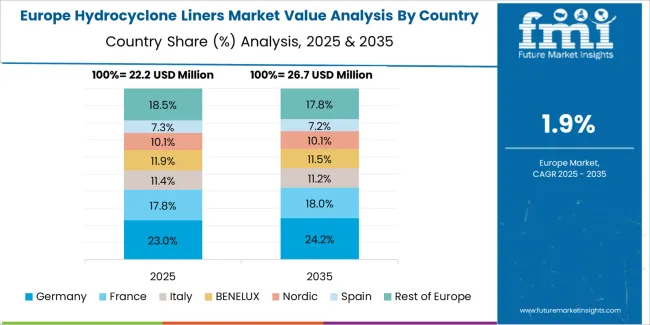
European hydrocyclone liner operations are increasingly concentrated between German engineering excellence and specialized processing across multiple countries. German facilities dominate high-performance separation liner production for precision processing and industrial applications, leveraging cutting-edge manufacturing technologies and strict quality protocols that command price premiums in global markets. British processing technology operators maintain leadership in industrial system innovation and separation liner method development, with organizations like specialized engineering companies and university research centers driving technical specifications that suppliers must meet to access major industrial contracts.
Eastern European operations in Czech Republic and Poland are capturing specialized production contracts through precision manufacturing expertise and EU compliance standards, particularly in component fabrication and assembly technologies for processing applications. These facilities increasingly serve as development partners for Western European processing programs while building their own industrial technology expertise.
The regulatory environment presents both opportunities and constraints. European industrial safety framework requirements create quality standards that favor established European manufacturers and processing system operators while ensuring consistent performance specifications for critical processing infrastructure and safety applications. Brexit has created complexity for UK processing collaboration with EU programs, driving opportunities for direct relationships between British operators and international separation liner suppliers.
Technology collaboration accelerates as processing companies seek technology advancement to support major industrial modernization milestones and facility development timelines. Vertical integration increases, with major industrial system operators acquiring specialized manufacturing capabilities to secure component supplies and quality control for critical processing programs. Smaller industrial contractors face pressure to specialize in niche applications or risk displacement by larger, more comprehensive operations serving mainstream processing and separation requirements.
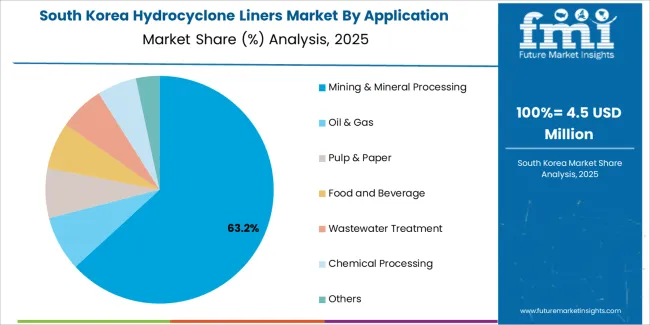
South Korean hydrocyclone liner operations reflect the country's advanced industrial technology capabilities and export-oriented processing development model. Major industrial system operators including POSCO and technology companies drive component procurement strategies for their processing facilities, establishing direct relationships with specialized separation liner suppliers to secure consistent quality and performance for their industrial development programs and advanced processing technology systems targeting both domestic infrastructure and international collaboration projects.
The Korean market demonstrates particular strength in integrating separation liner technologies into automated processing platforms and advanced industrial system configurations, with engineering teams developing solutions that bridge traditional mineral processing liner applications and next-generation industrial systems. This integration approach creates demand for specific performance specifications that differ from conventional applications, requiring suppliers to adapt liner capabilities and system coordination characteristics.
Regulatory frameworks emphasize industrial safety and processing system reliability, with Korean industrial standards often exceeding international requirements for separation liner systems. This creates barriers for standard component suppliers but benefits established manufacturers who can demonstrate industrial-grade performance capabilities. The regulatory environment particularly favors suppliers with Korean processing system qualification and comprehensive testing documentation systems.
Supply chain excellence remains critical given Korea's processing focus and international collaboration dynamics. Industrial system operators increasingly pursue development partnerships with suppliers in Japan, Germany, and specialized manufacturers to ensure access to cutting-edge separation liner technologies while managing infrastructure risks. Investment in processing infrastructure supports performance advancement during extended facility development cycles.
International Syalons leads the market with 18.7% share owing to its specialized ceramic liner technology and established mining industry relationships, which operators use to implement advanced separation solutions across diverse mineral processing applications. Profit pools are consolidating upstream in advanced material development and downstream in application-specific solutions for mining operations, industrial processing, and specialized separation markets where performance reliability, wear resistance, and consistent efficiency command substantial premiums. Value is migrating from basic liner component production to specification-driven, application-ready separation systems where material expertise, precision manufacturing, and reliable integration capabilities create competitive advantages.
Several archetypes define market leadership: established ceramic technology companies defending share through comprehensive material development and proven mining industry support; German industrial suppliers leveraging manufacturing excellence and engineering capabilities; American technology leaders with processing expertise and industrial heritage; and emerging material manufacturers pursuing advanced formulation development while building specialized application capabilities.
Switching costs - system integration, equipment compatibility validation, performance certification - provide stability for established suppliers, while technological advancement requirements and specialized application growth create opportunities for innovative material manufacturers. Consolidation continues as companies seek manufacturing scale; direct mining partnerships grow for specialized applications while traditional industrial distribution remains relationship-driven. Focus areas: secure premium mining and industrial processing market positions with application-specific performance specifications and technical collaboration; develop separation liner technology and advanced material capabilities; explore specialized applications including oil and gas processing and chemical separation requirements.
| Stakeholder Type | Primary Advantage | Repeatable Plays |
|---|---|---|
| Ceramic Technology Leaders | Advanced material expertise; proven mining integration; established operator relationships | Material innovation; technical collaboration; mining certification support |
| Industrial Material Suppliers | Manufacturing excellence; comprehensive processing development programs; established customer partnerships | Engineering collaboration focus; integrated solutions; technical consultation |
| Processing Technology Leaders | Separation system expertise; precision technology leadership; trusted by major processing programs | Industrial partnerships; application-specific specifications; processing infrastructure collaboration |
| Emerging Material Producers | Material innovation; competitive performance; rapid technology development | Production scaling; technology advancement; market entry strategies |
| Industrial Distributors | Technical distribution networks; processing service relationships | Industrial expertise; inventory management; technical support services |
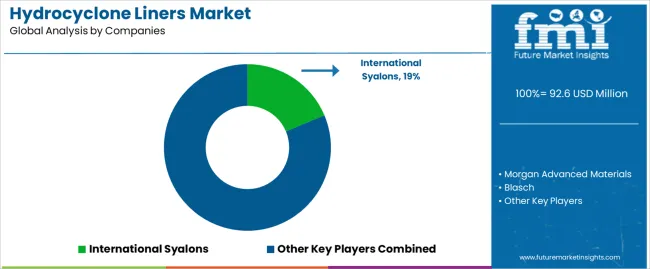
| Item | Value |
|---|---|
| Quantitative Units | USD 92.6 million |
| Type Segments | Ceramic; Rubber; Polyurethane; Metal-Backed; Composite Materials; Others |
| Applications | Mining & Mineral Processing; Oil & Gas; Pulp & Paper; Food and Beverage; Wastewater Treatment; Chemical Processing; Others |
| End-Users | Mining Companies; Industrial Equipment Manufacturers; Processing Plant Operators; Water Treatment Facilities; Oil & Gas Companies; Others |
| Material Segments | High Wear Resistance; Chemical Resistant; Temperature Resistant; Standard Performance; Others |
| Size Ranges | Small Diameter (up to 150mm); Medium Diameter (150-500mm); Large Diameter (500mm+); Others |
| Regions Covered | North America; Latin America; Europe; Asia Pacific; Middle East & Africa |
| Key Countries | China; India; Germany; Brazil; United States; United Kingdom; Japan (+35 additional countries) |
| Key Companies Profiled | International Syalons; Morgan Advanced Materials; Blasch; Tega Industries; Matec Solutions; GTEK MINING; Iracore; SHANVIM; Multotec; Swagath Urethane; UMAHU; NAN ATCERA; Premier Rubber Mills; Sands Ceramic |
| Additional Attributes | Dollar sales by type and application; Regional demand trends (NA, EU, APAC); Competitive landscape; Mining vs. industrial adoption patterns; Mineral processing and separation system integration; Advanced material innovations driving performance enhancement, wear resistance, and operational efficiency excellence |
By Type
The global hydrocyclone liners market is estimated to be valued at USD 92.6 million in 2025.
The market size for the hydrocyclone liners market is projected to reach USD 114.0 million by 2035.
The hydrocyclone liners market is expected to grow at a 2.1% CAGR between 2025 and 2035.
The key product types in hydrocyclone liners market are ceramic, rubber, polyurethane, metal-backed, composite materials and others.
In terms of application, mining & mineral processing segment to command 61.4% share in the hydrocyclone liners market in 2025.






Full Research Suite comprises of:
Market outlook & trends analysis
Interviews & case studies
Strategic recommendations
Vendor profiles & capabilities analysis
5-year forecasts
8 regions and 60+ country-level data splits
Market segment data splits
12 months of continuous data updates
DELIVERED AS:
PDF EXCEL ONLINE
Box Liners Market Size and Share Forecast Outlook 2025 to 2035
Industry Share Analysis for Box Liners Companies
Pan Liners Market
Pond Liners Market Analysis - Size, Share, and Forecast Outlook 2025 to 2035
Tray Liners Market
Panty Liners Market
Europe Liners Market Size and Share Forecast Outlook 2025 to 2035
Carton Liners Market Size and Share Forecast Outlook 2025 to 2035
Cheese Liners Market
Medical Liners Market Size and Share Forecast Outlook 2025 to 2035
Bladder Liners Market Growth – Trends & Forecast 2025 to 2035
Foam Cap Liners Market Size and Share Forecast Outlook 2025 to 2035
Truck Bedliners Market Outlook- Trends & Forecast 2025 to 2035
Understanding Market Share Trends in Foam Cap Liners
Commodity Liners Market Size and Share Forecast Outlook 2025 to 2035
Patient Recliners Market Size and Share Forecast Outlook 2025 to 2035
Inner Bulk Liners Market Size and Share Forecast Outlook 2025 to 2035
Irrigation Liners Market
Anti-Static Liners Market Size and Share Forecast Outlook 2025 to 2035
Market Share Insights of PVC-Free Cap Liner Manufacturers

Thank you!
You will receive an email from our Business Development Manager. Please be sure to check your SPAM/JUNK folder too.
Chat With
MaRIA